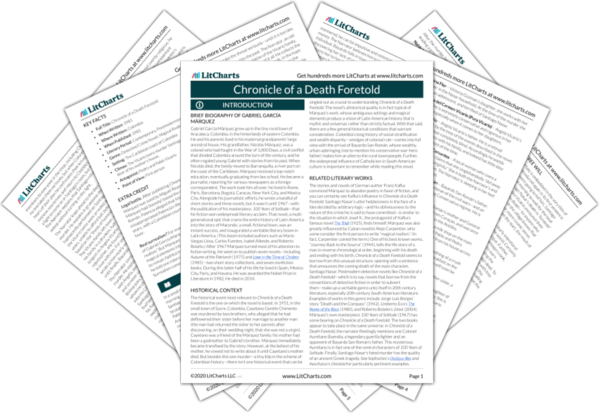Welcome to the LitCharts study guide on Gabriel García Márquez's Chronicle of a Death Foretold. Created by the original team behind SparkNotes, LitCharts are the world's best literature guides.
Death Foretold: Introduction
Death Foretold: Plot Summary
Death Foretold: Detailed Summary & Analysis
Death Foretold: Themes
Death Foretold: Quotes
Death Foretold: Characters
Death Foretold: Symbols
Death Foretold: Theme Wheel
Brief Biography of Gabriel García Márquez

Historical Context of Chronicle of a Death Foretold
Other Books Related to Chronicle of a Death Foretold
- Full Title: Chronicle of a Death Foretold
- When Written: 1981
- Where Written: Colombia
- When Published: 1981
- Literary Period: Contemporary, Postmodernism
- Genre: Detective/Crime Novel, Magical Realism
- Setting: The Caribbean coast of Colombia
- Climax: The Vicario twins murder Santiago Nasar at the door of his mother’s house.
- Antagonist: Pedro and Pablo Vicario
- Point of View: First person
Extra Credit for Chronicle of a Death Foretold
Legal battle. After publishing Chronicle of a Death Foretold, Márquez was sued by Miguel Reyes Palencia, on whom Márquez had (loosely) based the character of Bayardo San Román. Palencia alleged that Márquez had unlawfully misappropriated Palencia’s life. The legal dispute lasted for 17 years, with a Colombian court eventually ruling in Márquez’s favor.
Real surrealism? For many, it is impossible to describe the work of Gabriel García Márquez without uttering the words “magical realism.” But Márquez insisted that he never introduced magical elements into his fictions; rather, he wanted his fictions to remain faithful to life, and surrealism resulted from this. As he told one interviewer: “Surrealism runs through the streets. Surrealism comes from the reality of Latin America.”












